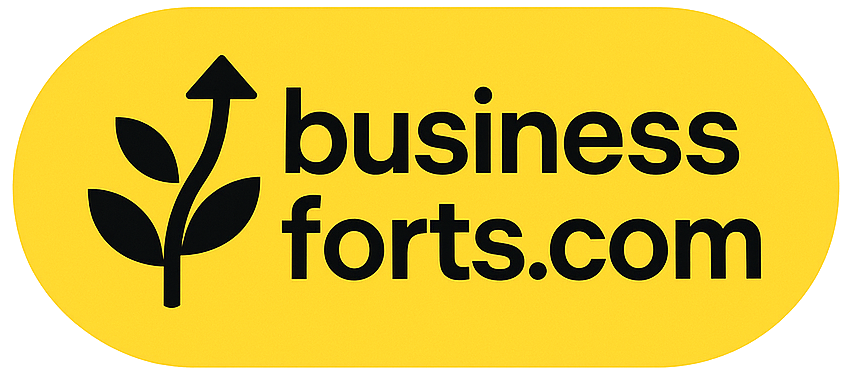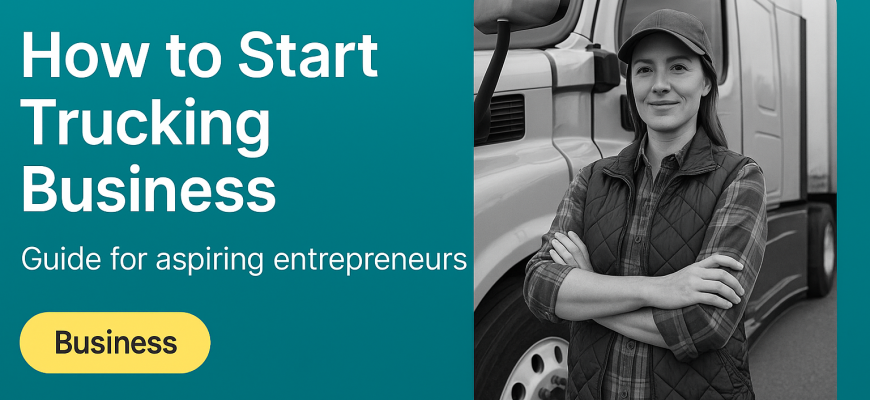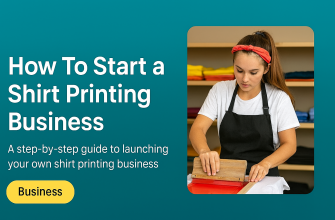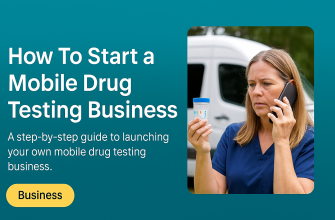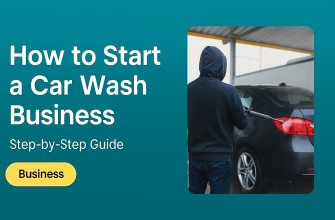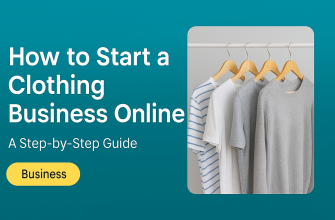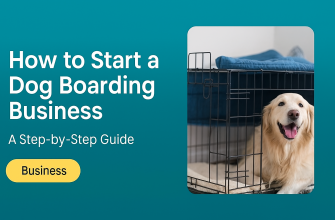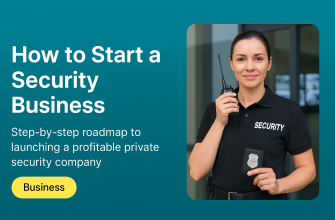Welcome to the trucking industry! If you’re a woman dreaming of running your own trucking company, you’re stepping into a field where female entrepreneurs are still rare – and that’s exactly why your journey is so powerful. Women make up only about 10% of professional truck drivers, and an even smaller percentage of trucking business owners. This guide will walk you through the essentials of starting a trucking business from scratch. We’ll cover practical steps (like licenses, registrations, and equipment) and give you a motivational boost to embrace this male-dominated industry with confidence.
- Step 1: Do Your Homework and Make a Plan
- Step 2: Get Your Commercial Driver’s License (CDL) – If You Plan to Drive
- Step 3: Register Your Business and Make It Official
- Step 4: Handle Trucking Permits and Legal Requirements (USDOT, MC Number, etc.)
- Step 5: Secure Proper Insurance Coverage
- Step 6: Acquire Your Truck (Lease vs. Own) and Necessary Equipment
- Step 7: Calculate Your Startup Costs and Explore Financing Options
- Step 8: Build Your Support Network and Embrace a Success Mindset
- You’ve Got This!
Step 1: Do Your Homework and Make a Plan
Every great business starts with a solid plan. Begin by researching the trucking industry and mapping out your business idea. Consider questions like: What kind of trucking services will I offer? Will I haul local loads or go interstate? What type of freight interests me (general goods, refrigerated items, specialty loads, etc.)? Understanding the niche you want to fill will help shape your decisions.
Next, think about your business model and role. There are a couple of common setups in trucking, each with pros and cons:
-
Owner-Operator (Solo Driver-Entrepreneur): This means you own (or lease) a truck and drive it yourself. Pros: You have full control over your schedule and loads, you don’t have to pay a driver’s salary, and you gain firsthand industry experience. You keep a larger share of profits because you’re doing the driving. Cons: Your earnings are limited to what one truck (and one driver – you!) can generate, which can cap growth. It’s physically and mentally demanding to run the business and drive long hours. If you take time off, the truck isn’t making money. However, many people start as owner-operators to learn the ropes and keep startup costs manageable before expanding.
-
Fleet Owner (Hiring Drivers): In this setup, you operate the business and hire one or more drivers to run the trucks. You might start with one truck and driver and grow from there. Pros: You can scale the business beyond your personal driving capacity – potentially running multiple trucks and serving more customers. This lets you focus on managing and growing the company (finding loads, handling operations) rather than being on the road all the time. Cons: It requires more capital and overhead – you’ll have to pay drivers (even during slow periods), handle payroll, and possibly manage higher insurance costs for multiple employees. You’ll also rely on employees to maintain your company’s safety and service standards. Managing people and operations can be complex if you’re new to logistics. That said, with good hiring and training, many women successfully lead their own fleets.
Take time to decide which path aligns with your skills, resources, and long-term vision. Some women choose to start by driving their own truck (even part-time) to understand the business deeply, then transition into an executive role as they expand. Others who prefer the management side from the start may partner with an experienced driver or hire one while they focus on business operations. There’s no one “right” way – it’s about what works for you. Write down your plan, including the services you’ll offer, the region you’ll operate in, and how you envision your business model. This will become the foundation of your trucking business plan (which is also useful if you seek financing).
Step 2: Get Your Commercial Driver’s License (CDL) – If You Plan to Drive
One of the first practical steps is getting properly licensed. If you intend to drive the truck yourself (owner-operator route), you will need a Commercial Driver’s License. Most likely, that means a Class A CDL for operating a combination vehicle like a tractor-trailer (needed for semi-trucks hauling typical freight trailers). Obtaining a CDL involves passing written exams and a road test, and many prospective drivers attend a truck driving school for training. The cost of training and licensing varies by state – for example, a CDL training program can cost several thousand dollars in tuition. While this is a significant investment of time and money, consider it an investment in your own skills that can open the door to owning and operating a truck profitably.
If you have no logistics or driving background, a CDL course will teach you essential knowledge about safety, vehicle operation, and regulations. Even if you ultimately decide to hire drivers and not drive yourself regularly, having a CDL can be beneficial. It gives you credibility with drivers, a deeper understanding of their job, and flexibility to step in and drive in a pinch. However, if you absolutely don’t plan on driving, you can skip the CDL and focus on the business side – just remember you’ll need to hire licensed CDL drivers. (Many women entrepreneurs do this and run the company as a dispatcher/manager.) Either way, make sure someone behind the wheel of your trucks has the proper license and endorsements for the type of freight you’ll carry.
Tip: While working on your CDL or getting to know the industry, start networking. Talk to other truckers, join online forums or social media groups for truck drivers and small carriers, and connect with mentors. Building relationships early can help you learn insider tips and find support as you launch your company.
Step 3: Register Your Business and Make It Official
With your initial plan in place (and perhaps your CDL in hand), it’s time to legally set up your trucking business. This step makes you an official company and lays the groundwork for taxes, finances, and hiring. Key actions include:
-
Choose a Business Name and Structure: Pick a name for your company that resonates with you and is professional. Then decide on a legal structure. Many small trucking businesses register as a Limited Liability Company (LLC), which is often recommended for its liability protection (it helps separate your personal assets from business debts or legal issues). An LLC or corporation can protect you if something goes wrong on the road, whereas a sole proprietorship does not provide that shield. Research what structure fits your needs – if unsure, an LLC is a solid default for many startups.
-
Register with the State: File the paperwork to register your business in your home state. This usually means filing “Articles of Organization” for an LLC (or similar documents for other structures) with your state’s Secretary of State or business bureau. The filing fee ranges widely by state (approximately $50 up to $800 in some states). This step officially creates your company.
-
Obtain an EIN (Employer Identification Number): An EIN is a Federal Tax ID number from the IRS, used to identify your business for tax purposes. It’s quick, easy, and free to apply for an EIN online at the IRS website. Even if you don’t plan to have employees immediately, you’ll likely need an EIN to open business bank accounts, apply for licenses, and file taxes.
-
Business Bank Account and Finances: Open a separate business checking account once you have your EIN and LLC paperwork. Keeping your business finances separate from personal finances is important for liability protection and accounting clarity. It will also make life easier when tracking income and expenses or applying for loans. Start building a financial record for your company from day one.
Taking these steps sets you up as a legitimate business entity. Not only does this protect you legally, but it also signals professionalism to future clients, lenders, or partners. Pro tip: Organize your documents (LLC papers, EIN confirmation, etc.) in a safe place – you’ll need them often as you move through the next steps.
Step 4: Handle Trucking Permits and Legal Requirements (USDOT, MC Number, etc.)
Here’s where trucking businesses have extra hoops to jump through. Beyond a normal business license, trucking is heavily regulated – you must register for operating authority and comply with transportation laws. It may sound daunting, but we’ll break it down. These are the key registrations and permits you’ll need to operate a trucking company in the U.S.:
-
USDOT Number: This is a registration number from the Federal Motor Carrier Safety Administration (FMCSA). A USDOT Number is required for commercial carriers that operate across state lines or haul hazardous materials, and many states require it for intrastate commerce as well. The USDOT number is basically an ID for your trucking company that lets authorities track your safety record and compliance. You can apply for it on the FMCSA website. (There’s no fee for a USDOT number alone, but it’s often obtained alongside your MC number, which does have a fee – see below.)
-
Operating Authority (MC Number): If you plan to operate as a for-hire carrier hauling other companies’ cargo (especially across state lines), you need to get operating authority from FMCSA. This is commonly called an MC Number (MC stands for Motor Carrier). Applying for your MC number involves a form and a fee of about $300 to the FMCSA. Once granted, this authority gives you the legal right to book and haul freight across states under your own company name. Important: the FMCSA’s approval for operating authority can take several weeks to process. You’ll also be required to have insurance in place (Step 5) before they fully activate your authority. Plan accordingly and apply early so you’re not stuck waiting to start operations.
-
BOC-3 Filing: When you apply for operating authority, you’ll need to file a BOC-3 form, which designates a process agent in each state. In simple terms, this means you have a representative to receive any legal notices or paperwork on your behalf in every state you operate. Usually, you hire a service to do this filing for a small fee, and they provide the nationwide coverage. It’s a one-time filing (unless your details change) that is mandatory for all interstate trucking companies.
-
Unified Carrier Registration (UCR): The UCR is an annual registration program that applies to most trucking businesses operating across state lines. It’s essentially a yearly fee (scaled to the number of trucks in your fleet) that funds state safety programs. You register online each year and pay the fee to stay compliant. It’s relatively straightforward – just mark it on your calendar to renew annually.
-
IRP and IFTA: These acronyms cover how trucks are registered and taxed for fuel when operating in multiple states. IRP (International Registration Plan) is a license plate program that lets you register your vehicle for operation in all lower 48 states (and Canadian provinces) with one apportioned plate, while paying registration fees based on the miles you run in each jurisdiction. IFTA (International Fuel Tax Agreement) is an agreement among states to simplify fuel tax reporting – you’ll have one fuel tax license and file quarterly reports of miles driven in each state, so fuel taxes can be properly apportioned. If you run only within one state, you might not need IRP/IFTA; but anyone doing interstate trucking with commercial vehicles will need to set these up. Typically, you apply for IRP and IFTA through your home state’s motor vehicle or transportation department once you have your other registrations.
-
Heavy Vehicle Use Tax (HVUT): This is an annual IRS tax (Form 2290) for heavy trucks (over 55,000 lbs gross weight) that use public highways. If you’re running a big rig, you’ll file this each year and pay a fee (around $550 for a typical tractor-trailer). It’s one more item for the checklist – usually you handle this after you have your truck, since you need the Vehicle Identification Number and weight.
It’s a long list of requirements, no doubt. The good news is help is available. You can consult a transportation attorney or compliance service to guide you through these steps. Many new trucking entrepreneurs choose to use a startup service that, for a few hundred dollars, will handle filing your LLC, EIN, DOT/MC applications, BOC-3, and more in one package. Whether you DIY or get professional help, make sure all your legal boxes are checked before your truck hits the road. Operating without proper authority or permits can lead to hefty fines or being shut down. It’s worth the upfront effort to do it right.
Empowerment Note: Don’t let the alphabet soup of regulations scare you off. Every trucking company – even the big ones – had to do this paperwork. You are just as capable of navigating it as anyone else. Take it one step at a time, and don’t hesitate to ask questions or seek guidance. Completing these requirements will be a proud moment – it means your company is officially licensed to operate!
Step 5: Secure Proper Insurance Coverage
Trucking insurance is a must-have and a significant part of your startup planning. Because trucks are large, valuable, and potentially dangerous vehicles, you’re required to carry substantial insurance before you can operate. In fact, proof of insurance is required to activate your FMCSA operating authority – regulators want to be sure that you can cover any accidents or claims. Key policies you’ll need include:
-
Commercial Auto Liability Insurance: This covers damage or injury to others if one of your trucks is at fault in an accident. The FMCSA requires a minimum of $750,000 in liability coverage for interstate carriers, but in practice most shippers and brokers will expect $1,000,000. This is your primary and most expensive insurance component.
-
Cargo Insurance: This covers the value of the freight you haul, in case it’s damaged or stolen in transit. A typical requirement is $100,000 in cargo coverage for general freight (higher if you haul high-value goods).
-
Physical Damage Insurance: This covers damage to your own truck and trailer (for example, if you collide with something or in a rollover). While not mandated by law, it’s essential if you have a loan or lease on the truck, and wise to have regardless, to protect your assets.
-
Other Coverages: You might also get general liability (for non-trucking business liability), bobtail insurance (liability coverage when the truck is being driven without a trailer), and workers’ compensation or occupational accident insurance (especially if you have employees or if you’re an owner-operator who wants coverage for on-the-job injuries).
Be prepared: insurance will be one of your largest ongoing expenses. For a new trucking company with a single truck, annual insurance can range roughly $15,000 to $25,000 per year, per truck (costs vary based on your location, equipment, driver experience, and safety record). Often you’ll need to put a down payment of around 10-25% of the annual premium to get started – that could be on the order of a few thousand dollars upfront. Make sure to get quotes from multiple insurance agents (preferably ones who specialize in trucking insurance) to compare rates and coverage.
While these numbers might seem high, remember that insurance is your safety net. In an industry with risks (accidents, cargo theft, etc.), the right insurance protects you from catastrophic financial hits that could destroy your business. It’s also legally required, so there’s no skimping here. Build it into your budget from day one. Over time, as you establish a safety record, you might earn better rates. Until then, drive safely and manage risks carefully – prevention is the best way to keep insurance costs in check.
Step 6: Acquire Your Truck (Lease vs. Own) and Necessary Equipment
Now for one of the most exciting (and expensive) steps: getting your truck! Your truck (and possibly a trailer) will be the core tool of your business. When starting out, you have a few options:
-
Buy New Equipment: Purchasing a new truck means you’ll get the latest technology, better fuel efficiency, and usually a warranty. Pros: High reliability (less downtime for repairs), dealer support, and warranty coverage for major issues. Cons: Very high upfront cost – a brand-new semi-truck can cost anywhere from roughly $80,000 up to $150,000 (or more) depending on the model and features. A new trailer (e.g., a 53-foot dry van) might add another $30,000–$50,000. Most people can’t pay cash for that, so you’d need a hefty down payment and financing plan (loans).
-
Buy Used Equipment: Purchasing a used truck can significantly lower your initial cost. Pros: Lower purchase price – used heavy trucks might range widely from about $30,000 (older, high-mileage rigs) to $80,000+ for newer secondhand units. Some used trucks in good condition can be bargains, and you avoid the steep depreciation hit new trucks take in their first years. Cons: Higher risk of maintenance issues – an older truck could need frequent repairs, which means downtime and costs. No factory warranty (unless you buy a certified used truck that includes some warranty). In some cases, a “cheaper” truck could cost more in the long run if it’s not reliable. It’s crucial to have a trustworthy mechanic inspect any used truck before buying, and budget extra for maintenance.
-
Lease a Truck: Leasing means you rent the truck from a leasing company for a set period (often 3-5 years) with monthly payments, instead of buying it outright. Pros: Much lower upfront cost (sometimes just a security deposit or first month’s payment). Maintenance may be included in full-service leases, and at the end of the term you can upgrade to a newer truck easily. It’s a good way to access the equipment you need without a huge investment, which is helpful when starting out. Cons: You don’t build equity – you won’t own the truck at the end (unless it’s a lease-to-own arrangement). You might have mileage limits or wear-and-tear charges. Over a long period, leasing can cost more than owning if you could have kept a purchased truck on the road for many years.
Many new trucking entrepreneurs end up financing a truck purchase – essentially taking out a loan for the truck, which often requires around 10% down payment up front. For example, a used truck priced at $50,000 might require $5,000 down; a $120,000 new truck might need $12,000 or more down. The bank or lender then owns a lien on the truck, and you pay monthly installments. The altLINE trucking startup guide estimates an average down payment around $18,000 for truck and trailer together, but this will vary based on the cost of your equipment and your credit. The key is to shop around for financing deals – some lenders specialize in commercial truck loans or equipment financing. Having a good credit score or some collateral will help in securing better interest rates.
Don’t forget you may also need to acquire a trailer (if you plan to haul freight in a trailer you own). Some owner-operators start by pulling trailers provided by their customers or leased from companies, but owning your trailer can give you more independence and possibly extra income (you could haul freight for others with your trailer). Trailers come in various types (dry van, flatbed, refrigerated, etc.), and, as mentioned, can cost tens of thousands of dollars. You can also lease trailers or buy used ones to save cost initially.
Aside from the big-ticket items, budget for other equipment and setup costs: An Electronic Logging Device (ELD) to record drivers’ hours (mandated for most trucks) – about a few hundred dollars; GPS and communication devices; tools and safety gear for your truck; and maybe an office setup (computer, printer, load management software, etc.). These smaller pieces can add up to a couple thousand dollars in total, so include them in your startup plan.
Leasing vs. Owning – which to choose? If you have the capital or financing to buy a reliable truck, owning can save you money in the long run (no monthly lease forever, and you have an asset that you could sell). But if your priority is conserving cash at startup, leasing is a valid option. Some entrepreneurs lease first to get the business rolling and then buy a truck later when revenue is coming in. There’s no shame in leasing equipment; just read the contract terms carefully.
Finally, ensure your truck meets all safety and regulatory requirements. When you put a truck on the road under your authority, it will need to pass regular inspections and comply with regulations (like weight limits, emissions standards if applicable, etc.). Keep up with maintenance – a well-maintained truck is not only safer but also less likely to break down and derail your earnings.
Step 7: Calculate Your Startup Costs and Explore Financing Options
By now you can see that starting a trucking business requires an investment. It’s time to crunch the numbers and figure out how to fund your dream. Let’s summarize some realistic startup costs for a single-truck operation (your situation may vary):
-
CDL Training and Licensing (if applicable): Potentially $3,000–$7,000 (varies by school) for a training course, plus fees for tests and the license. If you’re not getting a CDL, you might spend some money on industry training or consulting to get up to speed, but we’ll assume $0 here for non-drivers.
-
Business Registration Fees: Around $150–$400 on average (state LLC filing fee, plus any assumed name registration, etc.), though it can be up to ~$800 in high-cost states. EIN is free. Maybe add a few hundred if you use a lawyer or service to set up the LLC.
-
FMCSA Authority and Permits: $300 for the MC authority application. A BOC-3 filing service might be ~$50. UCR fee for one truck is in the ~$60 range annually. IRP registration will depend on your state and how many states you run in – could be several hundred to over a thousand dollars (often paid as part of your truck registration). HVUT is up to $550 per year. Let’s estimate perhaps $1,000–$2,000 total for all your various initial federal/state permits and taxes. (If you hire a service package, those fees might be bundled – for example, Apex Capital notes their full-service startup clients pay around $1,000–$1,600 including many of these fees.)
-
Truck and Trailer Down Payment or Lease Deposit: This will be your biggest line item. If buying with financing, as mentioned, plan on maybe 10-20% of the equipment cost. That could be $10,000–$20,000 (or more) depending on what you buy. If leasing, the upfront might be lower – for instance, some leases only need one or two months’ payment upfront, which could be a few thousand dollars. Let’s use an example from industry averages: roughly $18,000 as a down payment towards a truck and trailer (your case might differ).
-
Insurance Down Payment: Many insurance companies require a percentage of the annual premium up front. Suppose your yearly premium is $18,000; a common down payment is 20-25%, which would be around $3,600–$4,500. The altLINE guide estimated about $4,000 down for insurance on a new trucking company. You’ll then have monthly payments for the insurance (or sometimes the remainder in a few large installments).
-
Working Capital (Fuel, Expenses before Income): Don’t forget you need some cash to cover operating expenses in the first few weeks or months before your customer payments start rolling in. Fuel is a huge ongoing cost – one fill-up for a semi-truck can be hundreds of dollars. You may also have to pay for repairs, tire replacements, or unexpected costs early on. It’s wise to have a cushion – perhaps a few thousand dollars reserved for operating expenses. Many new owner-operators underestimate this; remember, most shippers/brokers pay on net 15-30 day terms, so you might haul a load and not get paid for a month. You’ll need to buy fuel and pay drivers (if any) in the meantime.
When you tally all this, a realistic ballpark to start a single-truck operation is in the tens of thousands of dollars. In fact, owner-operators often report startup costs in the range of $10,000 to $30,000 (if using a used truck or leasing), and it can be more if you buy a newer truck outright or encounter high costs. It’s better to over-estimate and be prepared than to run short.
Now, how do you fund this? Don’t let the numbers scare you; with a smart strategy, you can secure the needed capital. Here are some financing options and tips:
-
Savings and Personal Investment: Many entrepreneurs start by investing their own savings. If you’ve been saving up or can liquidate other assets, this gives you the most control (no loans to repay). The downside is risk – you’re putting your own money on the line. Only use what you can afford and consider keeping a personal emergency fund separate from the business.
-
Bank Loans or Credit Union Loans: A traditional route is to get a small business loan or personal loan from a bank. Prepare a business plan to show the lender how you’ll use the money and repay it. If you have good credit and possibly collateral (like home equity or the truck itself), you could obtain a loan for equipment or working capital. The Small Business Administration (SBA) offers loans that might be suitable – an SBA 7(a) loan or SBA microloan could help fund equipment or startup costs, often with competitive interest rates. Some loans might require a 10-20% down payment or equity injection, so they can complement your own funds.
-
Equipment Financing: There are financing companies that specialize in truck loans or leases. These lenders use the truck (and trailer) as collateral. Even if you don’t qualify for a general business loan, you might still get an equipment loan because the asset secures it. Interest rates can vary, and for new businesses they might be a bit higher, but this is a common way to get your truck. Shop different dealers and financing companies to compare terms.
-
Leasing: As discussed in Step 6, leasing a truck is itself a financing method – it dramatically lowers the upfront cash needed. You might combine leasing with a small loan for other costs. For example, lease your truck (low upfront) but take a small loan or use credit cards for your permits/insurance. Be careful with high-interest credit, though, as debt can pile up quickly.
-
Grants and Special Programs: Believe it or not, free money is out there! There are grants aimed at helping small businesses, including those in transportation. Some grants focus on helping underrepresented entrepreneurs, such as women-owned businesses or minorities. For instance, the U.S. SBA has programs like the 8(a) Business Development Program for disadvantaged businesses, and various state or local grants might exist to support companies that create jobs in certain areas. Trucking-specific grants also pop up; industry sources note that there are “transportation grants for small businesses” that could cover registration or equipment costs – unlike loans, grants don’t have to be paid back (though they’re competitive). It requires research and effort to apply, but if you qualify, it’s worth a shot. A recent industry article even posed the question: Can you start a trucking company with no money? The answer was “a resounding yes” – by seeking financing and grants, some drivers have managed to launch with little of their own cash. In other words, be resourceful: explore nonprofit loans, community development financial institutions (CDFIs), or women-focused business grants. Every bit can help.
-
Factoring and Lines of Credit: Once you start running loads, you might encounter cash flow gaps (as mentioned, you pay for fuel and expenses long before customer payment arrives). Many trucking companies use freight bill factoring – basically selling your invoices to a factoring company to get paid immediately (they take a small percentage). This isn’t exactly startup funding, but it can keep your cash flowing early on. Similarly, opening a business line of credit with your bank can provide a safety net for operating expenses. These tools help ensure you don’t run out of cash while waiting for revenue.
Remember, start small and scale up. You don’t need a huge fleet on day one – you can start with one truck and grow over time. Keeping your initial costs as lean as possible will make it easier to achieve profitability. Many big trucking businesses began with a single rig and a lot of determination. With prudent financing and cost management, your trucking business can get off the ground without sinking you in debt. It’s all about finding the right balance for your situation.
Step 8: Build Your Support Network and Embrace a Success Mindset
Starting a trucking business involves much more than just paperwork and money – it also requires the right mindset and support system. As a woman entrepreneur in a non-traditional field, cultivating confidence and resilience is crucial. Here are some tips to strengthen your mental game and build a network around you:
-
Believe in Your Capability: It’s normal to wonder, “Am I really cut out for this?” Especially if you’re new to logistics, the learning curve can feel steep. But remind yourself of your strengths – whether it’s organization, people skills, determination, or a willingness to learn. Confidence is built step by step, not all at once. Every time you check off a task (like getting your LLC, passing a CDL test, or booking your first load), you’re proving to yourself you can do this. Keep a positive affirmation or vision in mind – for example: “I am a successful trucking business owner providing great service and breaking barriers.” It might sound cheesy, but mindset matters when challenges arise (and they will).
-
Find Mentors and Peers: Don’t go it completely alone. Connect with others who understand the journey. This could mean joining industry groups or associations. The Women In Trucking Association, for instance, offers mentorship, networking events, and a “Professional Driver Hub” full of tips and resources for women in the industry. Look for local meetups of trucking professionals or small-business owner circles. Online communities (Facebook groups, LinkedIn groups, trucking forums) can also be invaluable – sometimes you can get a question answered by experienced people in minutes online. Having a mentor or coach is particularly helpful; a seasoned business coach (like Alex Rivers or others who focus on women entrepreneurs) or an experienced trucking business owner can provide guidance, feedback, and moral support. Don’t be shy about reaching out – many people are happy to help newcomers, and one day you can pay it forward to another woman starting out.
-
Educate Yourself Continuously: Confidence grows as your knowledge grows. Take advantage of workshops, webinars, and training opportunities. Whether it’s a course on freight management software, a seminar on safety compliance, or a business management class, keep learning. The more competent you feel, the less any gender bias or self-doubt can affect you. Plus, being well-informed will earn respect from customers, drivers, and industry peers – you’ll know your stuff. As you operate, you’ll learn lessons (some the hard way) – treat mistakes as learning opportunities, not failures.
-
Surround Yourself with Supportive People: Entrepreneurship can be stressful. Let your friends and family know about your new venture and how important it is to you. Ideally, they’ll cheer you on and understand when you’re busy building your business. Also try to connect with other women in trucking – they understand the unique challenges and can offer advice on everything from work-life balance on the road to handling skepticism in the workplace. There’s a real camaraderie among women in this field, even if we’re still a minority. Lean on that community. Celebrate each other’s wins. Knowing others have succeeded can motivate you to push through hurdles.
-
Stay Determined and Resilient: The trucking industry, like any business, has ups and downs. Freight rates can fluctuate, trucks break down unexpectedly, clients come and go – it’s not always smooth sailing. Prepare yourself mentally that setbacks might happen, especially in the first year. Maybe your operating authority approval takes longer than expected, or your first driver quits, or you hit a slow freight season. These moments can be tough, but they’re normal in business. What will set you apart is your resilience. Have a plan B (and C) when possible, take a deep breath when things go wrong, and remind yourself why you started this journey. You’re building something worthwhile – your own company – and that’s worth fighting for. Keep your eyes on your goals, and don’t let temporary roadblocks derail your vision.
You’ve Got This!
Starting a trucking business as a woman with no logistics background might feel like a big leap, but step by step, it’s absolutely achievable. Picture yourself in a year: you’ve navigated the licenses, bought or leased that first truck, secured your insurance, and perhaps hauled your first loads. You’re earning income on your own terms. How empowering is that? Every major accomplishment begins with the decision to try, followed by persistent effort.
As you venture into this industry, remember that you are not alone. Other women have built successful trucking companies from the ground up – and you can be the next success story. Stay curious, stay courageous, and use both your brain and your heart: the brain for the practical business strategies, and the heart for the passion and purpose driving you forward. With careful planning, continuous learning, a supportive network, and a can-do spirit, you’ll not only start a trucking business – you’ll thrive in it.
Welcome to the journey of becoming a trucking business owner. The road may seem long, but the freedom and fulfillment of running your own show are worth it. Fasten your seatbelt, sister – it’s time to hit the road and make your mark in trucking!
Empowering Quote to Remember: “The question isn’t who’s going to let me; it’s who’s going to stop me.” – Ayn Rand. In other words, give yourself permission to succeed, and don’t let anyone or anything stop you from pursuing your dreams. Good luck and happy trucking!
